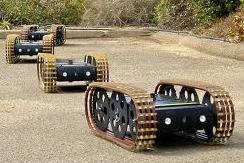 Wintergreen Research is publicizing a finding that the “…first responder and military ground robot marketplace will expand at close to 20% annually for the rest of the decade.” Furthermore, “Markets at $4.5 billion in 2013 reach $12.0 billion by 2019.”
Wintergreen Research is publicizing a finding that the “…first responder and military ground robot marketplace will expand at close to 20% annually for the rest of the decade.” Furthermore, “Markets at $4.5 billion in 2013 reach $12.0 billion by 2019.”
This is welcome news for the developers of Unmanned Ground Vehicles (UGV). Robohub points out that this projection is consistent with a Markets and Markets report that predicts a 17.4% CAGR for the same time period. Of course, any headline in the media must be greeted with a certain degree of skepticism. Do these projections make sense?
















 Every once in a while, someone asks me to translate military jargon, or more often summarize a lengthy statement into an “executive summary.” Here are a couple of examples of my attempts to convert a dense forest of words into a simple “take home message.”
Every once in a while, someone asks me to translate military jargon, or more often summarize a lengthy statement into an “executive summary.” Here are a couple of examples of my attempts to convert a dense forest of words into a simple “take home message.”

 emphasis placed on acquisition of Commercial Off The Shelf (COTS) products by the Department of Defense (DoD). In the past, COTS constituted a few percent of all items purchased by the DoD. While the overall amount is still low, some weapon systems are composed by as much as 50% of COTS. What are the good, the bad and the ugly about COTS?
emphasis placed on acquisition of Commercial Off The Shelf (COTS) products by the Department of Defense (DoD). In the past, COTS constituted a few percent of all items purchased by the DoD. While the overall amount is still low, some weapon systems are composed by as much as 50% of COTS. What are the good, the bad and the ugly about COTS?